Port Phillip Bay was calm and overcast. The wind was sprinkled with raindrops and the humidity was 90% with the temperature around 25 degrees C.
After being kept in our car for an eternity on the claustrophobic vehicle deck, we headed off into the wilds of Port Melbourne.
Finding a parking spot and telephone together, quite a feat when towing a caravan, Jacqui rang the GPO to see if our parcels had been forwarded on to Inverloch. No answer even at 9:10 AM and the payphone ate our money to boot. Frustrating!!
Deciding we weren't going into town, escape seemed the best plan. At a Solo service station in Port Melbourne we filled up for 60.4 CPL – cheap compared to Tassie - and joined what seemed like an endless traffic jam comprising mainly mega trucks, courier bikes, new Porsches, Jaguars and BMW's.
With the South eastern arterial came the rain which kept us to about 70Kmph with lights on.
Pulling off at Stud Road we found a parking spot in Dandenong, yep that's twice in one day, and did some shopping in a brand-new shopping centre. Here we were left almost speechless by the low cost of fruit. A basket of fruit cost us $13.00. In Tasmania it would have been $26 at least. Myers next for new sunnies and then onto Jayco to have the brakes on our van looked at. We got lost mainly because Jayco aren't where they said they are! Finding them eventually, they soon agreed we had a problem when they hooked our van onto a tractor, accelerated off then hit the brakes, our override unit didn't budge!
Agreeing we needed a new override unit there seemed to be a problem with the fact that we weren't the original owners. They were sympathetic but ”it is in the warranty”! An about face came quickly when Jacqui suggested they weren't prepared to stand by their product. “Perhaps we could get you another using the original purchaser’s name”. Having no override units in stock we were assured there would be one available when we passed through next week. Just as I was reconnecting the van to the car one of the service chaps returned with an override coupling in hand. We thanked him promising to return our faulty one as soon as possible.
Stopping for lunch at a nearby park, I had a close encounter of the unfortunate kind with the new override unit when it fell on my leg as I opened the boot to get the lunch things. Youch!
The trip to Inverloch was without incident except for one of those rainstorms where windscreen wipers appeared to serve no useful purpose whatsoever. The storm was short lived however, and the rest of the trip was in dry but overcast conditions.
Mum and Dad or Owie and Georgie had been unable to get an overnight van so had booked into the only motel in Inverloch. They left their car strategically visible and we were soon talking and organising.

Our campsite at Inverloch. At $21 per night it was the most expensive of our trip
At the caravan park which cost $21 per night, we booked in and paid for three nights. After setting up we chatted and opened a bottle of bubbly. It was a happy day for all as we had each missed the other having not been together since January 3rd.
Checkout the kid's reaction to Jacqui's "order" to vacate the adult chairs!
For Rohan, Owie and Georgie's arrival was especially significant as they brought with them a new bike for him.
Thursday 1st March 1990
Mum and Dad went into Melbourne to conduct some banking business and purchase airline tickets and travellers’ cheques for their forthcoming trip to Singapore and Darwin.
We agreed to meet at Cowes, Phillip Island, at 5:00 PM. The day was spent washing etc. and it was very pleasant not to be rushing.
Before leaving for Phillip Island we all walked ½Km to the town for supplies and a play in the park. Jacqui stopped in at the shell display Information office and we were given some good information about what to see in Western Australia (yes, I know this is Victoria) as well as sea shells to be careful around.

At Cowes we spent a few hours over dinner with mum and dad before leaving to inspect the motorcycle GP track. From there it took only 10 minutes to reach the penguin parade car park. Besides the hundreds of cars there were at least 10 huge and many smaller buses. Most were full of foreign tourists. Jacqui decided that each person should pay her $10 – making her rich.
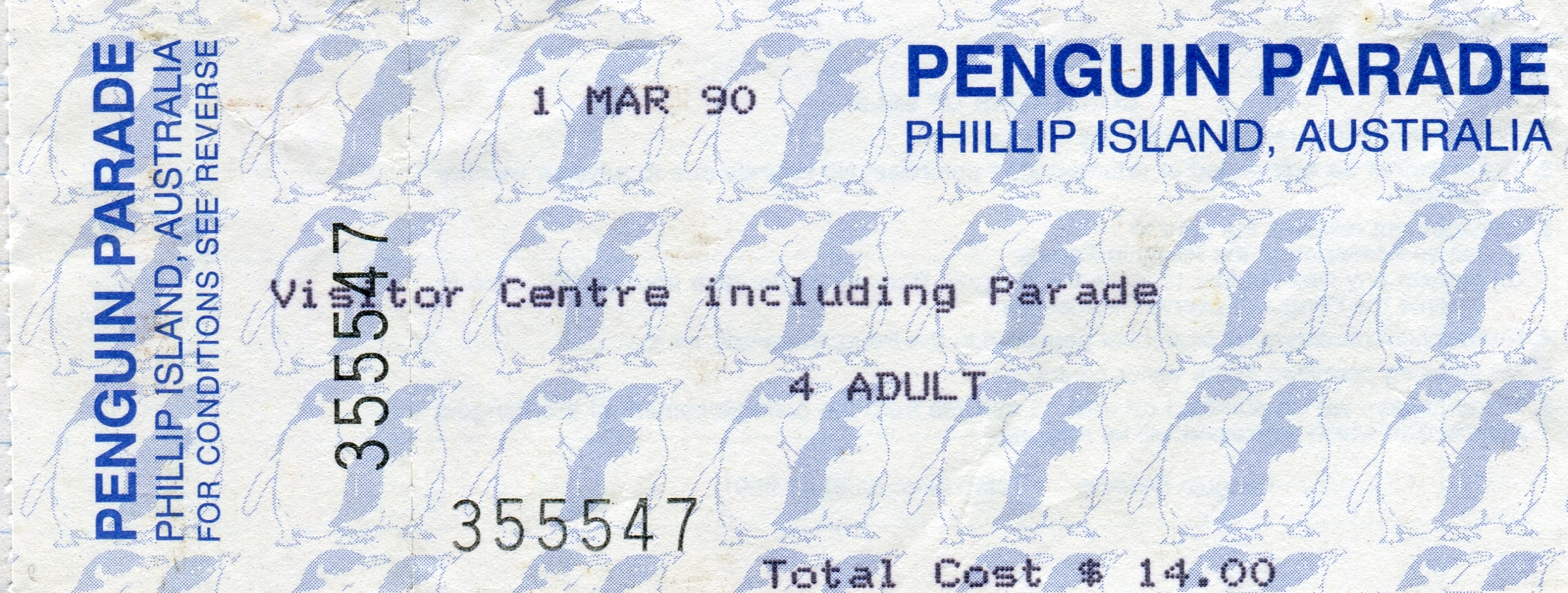
The visitors centre was impressive to look at from the outside and presented excellent displays on the inside.
As the sunset, we made our way along the wooden elevated boardwalk. Visible on either side were many burrows, some occupied by penguins that hadn't gone to sea as they were moulting.
The parade area consisted of concrete grandstand type seats with lights on top of metal polls which illuminated the beach for about 10 metres in front of the seats.
We received a pre-recorded talk on penguin biology and behaviour, followed by the same talk in Japanese and then in what sounded like Chinese.
Being low tide, the water’s edge was at least 50 metres away, but we could still make out the first penguins as they congregated in courage-building groups. A passing seagull or shearwater would have them retreat as they were justifiably fearful of the long, exposed walk on their very short legs.
Our advice to sit at the left-hand end was bad! We must have seen several hundred penguins but only 1 walked past the left-hand end. The rest walked right through the middle of the viewing area.
Of course, despite numerous warnings about not using flashes, several yobos tried to be inconspicuous while blinding the birds and the rest of us.
The best viewing, for us, came as we were leaving and we could look at the penguins on their nests either grooming, feeding young or displaying with wings spread making a strange sound. The whole sand dune seemed to be alive - penguins don't sleep on land!
Friday 2nd March 1990
After the mandatory shopping trip, we headed off for Wilsons Promontory. Anja and Rohan travelled with Owie and Georgie while Lachlan was our only passenger.
We travelled through dry grazing country before entering Wilsons Promontory National Park where thick tea tree scrub covered all but the exposed granite outcrops of the imposing mountains.
At Tidal River, we ate a barbecue lunch surrounded by numerous fellow tourists and hundreds of freeloading seagulls.

Picnicing at Wilsons Promontory with Ian's parents, Elaine and George AKA Owie and Georgie
The beach at Tidal River was beautiful, with fine yellow sand diving into a calm, blue-green sea, all embraced by granite boulders at either end.

Enjoying the beach at Wilsons Promontory with few others, except for seagulls
Mum and the kids swam in the warm to cold, depending on how far out you went, water and we all soaked up the sun. I asked a passing Ranger about spearfishing and he suggested Whiskey Bay where it was both legal and should be good.
So, to Whiskey Bay we went, and I suited up on the beach after carrying my gear 50 metres from the car park. Swimming out through the surf, I first went south but turned and swam to the north end of the beach as the rocks there looked more promising for spear fishing. By the time I swam the length of the beach, which was about 100 metres, I was tired and disappointed to find the sandy and rough conditions totally unsuitable for spearfishing. I returned to shore exhausted, hot and fish free.

Whiskey Bay where Ian went spearfishing without success
Dinner was sandwiches of the remaining barbecue sausages and salad. This time there was only one seagull who seemed to be telling us to rack off and about 1 million march flies who were intent on having us for dinner! No sooner would Jacqui declare she had killed them all than we were fighting the battle anew.
On the return journey Anja and Rohan travelled with us while Lachlan went with Owie and Georgie.
Shortly after leaving I noticed the image in the rear-view mirror was blurred and we both agreed the car was making an unusual high pitched sound. Thoughts of worn wheel bearings at best and worn gear boxes at worst ran through my mind. Relief! I Was driving at 100Kmph in second gear!
The sunset, as we returned to Inverloch, was spectacular. An excellent day!
Saturday 3rd March 1990
Dad's birthday dawned hot and clear. Before long, the kids were running around with sherbet sticks bought by George at the insistence of Lachlan. Sherbet sticks were, said George, the lesser of numerous evils available at the shop - fair enough!
Blissfully, George and Owie took the kids to the beach while we packed up the ‘van. From Inverloch the 10 kilometres didn't take long and we pulled into the state coal mine at Wonthaggi.

Here we were met by a 67 year old guide who showed us a model of an old mine where a disaster had occurred due to the bosses’ negligence during a coal miners’ strike. Next, we were all fitted with helmets. The kids were given white caps, presumably for hygiene purposes.
A short walk later and we started down the mine shaft that descended with a 1:4 gradient. The guide talking about many practises as we went. About halfway our guide was describing how rocks called greasy backs, which appeared perfectly sound, could fall and kill you. Jacqui decided that coal mining wasn't for her and retreated up the shaft - we found out later that this happens regularly.
The rest of the tour was informative. The working conditions were the pits (pun intended) especially when working narrow seams of only 30 centimetres high while lying on your side, wielding a pick or auger all in mud or dust.
The life of ponies down the mine was worse than the men's, if possible as they hauled skips full of coal or rock up steep and slippery slopes.
The mine, which had been closed since the 1920s, has had several leases of life since: as a film set, coal mine in the early 70s, a mushroom farm and now as a museum. One of the major problems with old mines is water. This one was pumped for four months at a rate of 10,000 gallons per hour to empty it for its current purpose. The floor also heaves, which means that the floor comes up to reach the ceiling - volunteers from the local miners have been clearing blocked shaft and replacing old timbers as a result.
Riding out in skips with seats we emerged in a parallel shaft, to that through which we descended, about 20 metres away.
After returning our helmets and thanking Wallis, our guide, we were escorted through the museum by an ex minor whom we reckon to be in his mid-80s. The museum was professionally prepared and revealed many aspects of the state mine's history, it's people and the lives they lead.
For lunch we ate quiches in a beautifully built shelter, before braving the 30Deg C heat on the road to Melbourne.
Instead of going to the Kmart at Stud Rd we shopped in a big shopping complex at Cranbourne.

Georgie after a successful shopping expedition - three grandchildren "on special" cheap at half the price, but ongoing maintenance could be a hidden cost!
As it was around 4:00 PM we decided to stay at a caravan park in Dandenong only to find on arrival that it was full. Instead we stayed at a motel down Frankston Road near Frankston.


Unable to find a caravan park with any vacancies we booked into the only Motel we stayed at during our trip in Frankston Victoria. Its pool was popular with everyone
For dinner we had a superb Chinese meal which Jacqui prepared with virtually no cooking equipment…..or did we get takeaway, I can't remember.
To coax the kids to sleep we watched an old Hitchcock movie called Suspicion, in black and white, that did the job. For us grownups however, the hot humid conditions made sleeping difficult.
Sunday 4th March 1990
On the road quickly, for us, we headed into Melbourne on the Nepean highway. After some skilful navigating by Jacqui, who was working with a sketched map, we made the Royal Melbourne Zoological Gardens by 11:00 AM.
The highlight for me was the many species of monkeys, at play and rest, in well thought out roomy (compared to other versions) cages with excellent viewing. Others enjoyed the butterfly exhibit, baby orangutan and the rides in the fun fair – Rohan's favourite. We spent until around 4:00 PM at the Zoo and enjoyed every minute.
Leaving Melbourne was much easier than finding the zoo, and before long we were travelling on the excellent freeway to Ballarat. Ballarat is large and spaced out. At the caravan park we got a campsite and Mum and Dad an on-site cabin with ensuite. Shortly after arriving I traced a strange engine noise to a worn water pump bearing which I will need to replace tomorrow.
Monday 5th March 1990
The morning was spent replacing the water pump in the car with a genuine GMH part that cost approximately $40. The old one wasn't GMH and lasted only 18 months, poor value at $30.
After lunch we went to Sovereign Hill gold mining village. At $36 per family it was expensive but well worth the money. The village's main street is newly constructed shops, built to look authentic, with reconstructed mining activities nearby. These ranged from panning in a simulated creek - an activity Lachlan, Anja and Rohan took to with gusto - to much more sophisticated steam driven crushers and pumps.
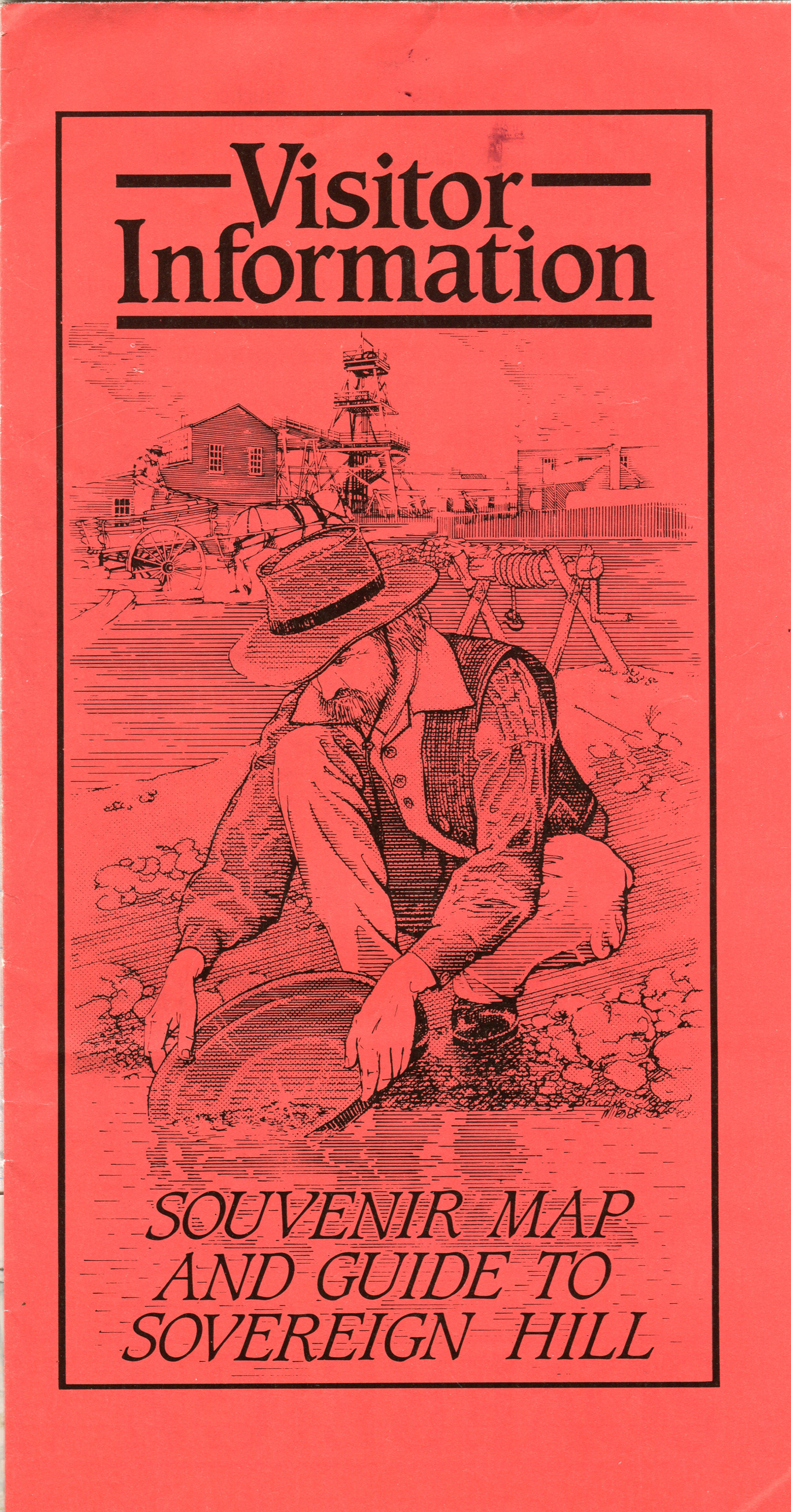
Everyone, except Jacqui, joined a tour of a mine which was especially constructed for the purpose. With wide, well-constructed and shored tunnels, it was a far cry from the real Wonthaggi mine. At short intervals were dioramas of various aspects of gold mining at Ballarat in the mid to late 1900s. Once more the appalling conditions of the miners were highlighted, although it was pointed out that they were well paid by the standards of the day.
Not sure where or when this video was taken, but it's such a lovely shot of the things you do when you have the time spend with your young children. One of the best things about this trip!
Above ground, and walking around the complex, were guides dressed in authentic costume. Some played out particular scenes while others were merely there and could be questioned about anything - even the meaning of life or Heisenberg’s uncertainty principle!
We indulged ourselves in a ride on a coach pulled by three large horses. The cabin of the coach moved about freely, suspended on leather “springs”. The coachman informed us that the leather in these springs is replaced yearly at a cost of $3000. Lachlan and I rode on the top with the driver - shotgun as it were, while Jacqui, Anja and George rode inside. At the conclusion of the short ride we all agreed that to spend days on end in the coach would be an uncomfortable experience, the well-padded leather seats notwithstanding.

We enjoyed our stagecoach ride at Sovereign Hill
At the blacksmith shop I bought a billy stand for $12.00 (a 70cm long spike with a movable billy hanger) from the smithy, a refugee from Dee Why. He had a large range of wrought iron goods on display ranging from boot scrapers to fireside accessory kits.

The kids also enjoyed drinking apple juice and eating in the 19th Century styled cafe at Sovereign Hill
Mum commented that the village was similar to Williamsburg in the USA. When she spoke to one of the shop assistants it was confirmed that the director of Sovereign Hill had visited Williamsburg before construction commenced here at Sovereign Hill.

A family portrait taken by Georgie at Sovereign Hill
Back at the Windmill caravan park we ate a superb baked dinner accompanied by a 1987 Wolf Blass Shiraz. Yum!
After dinner we decided to do a little exercise so it was off to Lake Wendouree. Here we found a large park. We watched swans, ducks, coots and musk ducks who expected all who stopped to feed them. At about the end of dusk we started chatting to a family from Orange NSW who had been selling T-shirts, belt buckles etc at a swap meet for old cars. They were driving a bus and we found they had bought it from Ann and Jim Barber of Lithgow (Ann went to school with Jacqui). Their names were Stephen and Margaret Benadiaca.

Lake Wendouree, Ballarat. That's George and Elaine's brown Mitsubishi Magna behind Jacqui
Tuesday 6th March 1990
After packing up the van, the gold museum, opposite Sovereign Hill, was first on the agenda. Here we spent the entire morning viewing displays outlining the history of Victoria and Ballarat, from aboriginal settlement, to the present. The curators had placed particular emphasis on gold, its mining and influence on the people. Also, on display were more general histories of gold and how it shaped world history. There were lots of pieces of gold on display, all genuine I might add. One display was particularly interesting, being a series of circular photographs in steel cylinders of various creeks in the Ballarat area. In each was a smaller cylinder containing alluvial gold obtained in that creek during the past 20 years by a particularly persistent prospector.
We lunched in the park at Lake Wendouree (it was cold - parker weather), then headed west for Halls Gap and the Grampians, some 120 kilometres away. During the trip, which we broke twice to change children, we travelled through sheep country over rolling hills.
After setting up camp we enjoyed a barbecue dinner and a walk down a local lane, before returning in the semi moonlight for a sing along.
Wednesday 7th March 1990
The day began with a trip along straight, tree lined, roads through brown paddocks to Best's Great Western Cellars.

The sales room is a slab hut, part of the original, complex, built in 1866. The bloke behind the counter showed little interested as I tasted the reds on offer. Most seem to lack body and showed the high acid content of young wines. We liked their whites and I bought 2 bottles of chenin blanc at $7.50 each and six of dry white which were quite drinkable at $3.50 each as well as a flagon of white port for $6.
All around the sales room were old pieces of equipment including a corker and hand wine pump which was in use until 1958, at which time power was connected to the site. Hanging on the walls were photographs of workers at the vineyard, dating back almost to its establishment, as well as some showing the vines under snow in 1981.
They allowed us to wander at will through the winery and we saw two workers turning and shaking champagne bottles. The bottles were sealed with crown seals and we were told that the disgorging occurred at Seppelts down the road. The sales room appeared to be the only old piece of equipment in use, the fermentation tanks, and bottling machines where new and shiny. Outside in the cool, partially cloudy, day everyone enjoyed an illicit grape or two from the high vines, some of which had had their wine grapes picked within the last day or two.
At Seppelts Great Western, the contrast with Best's was great. Seppelts is a a huge complex with four story high white cylinders lined up at least six abreast. The sales room simply dripped class with prices ranging from $4.10 for a bottle of Great Western champagne that we can buy in Sydney for a similar price to $3500 for an old bottle of Para Port.
In the tasting room, a suave young man did a good job guiding us through the complexities of champagne, illustrating by tasting, from $4 Imperial reserve to $23 dollars for Salinger. I could see why he more expensive wines were superior, but the difference didn't, in my opinion, justify a $19.00 premium.
We drove back to the Halls Gap for lunch and then onto the Grampians National Park. First stop was at the visitor centre for a look around, to pick up the inevitable map, and see the inevitable audio-visual programme.

Also, at the centre, we tried to identify a strange eucalypt which had been planted near our camp. It had hollow finger like covers for the anther and style which fall off during flowering. The fruit were in groups of about 10, fused together and the flower was green.
We drove to a lookout which gave a superb view of much of the Grampians, revealing the massive sandstone which, having been tilted to the northwest at about 30 degrees, produced the imposing cliffs, mountains and outcrops characteristic of this National Park.


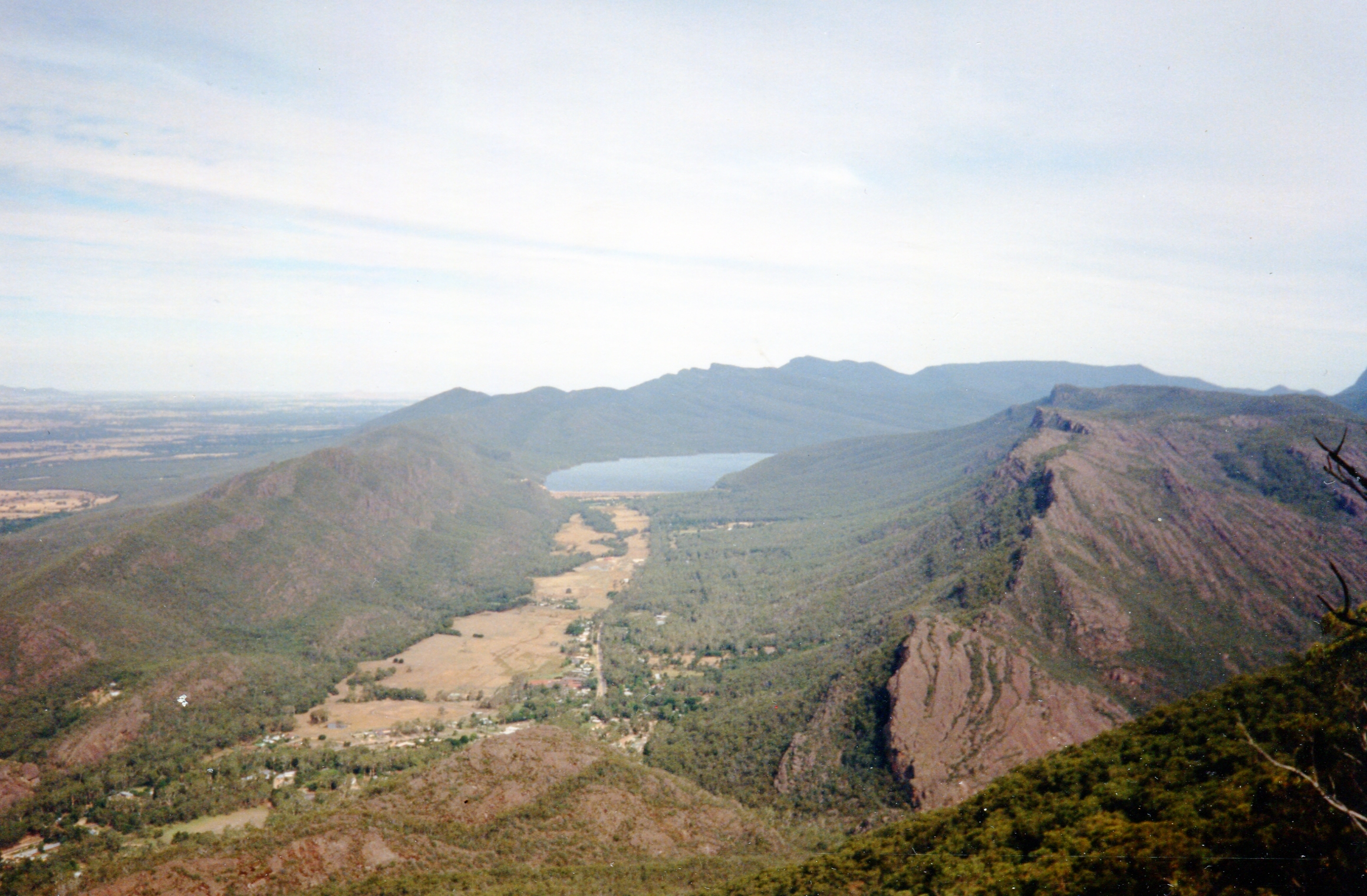
Grampians National Park most likely taken from the Boroka Lookout
As well as the mountains, the flat farmland, chequered with timbered country and crisscrossed by tree lined roads, was also impressive.

The farmland surrounding the Grampians N.P. probably taken from the Boroka lookout near Halls Gap
Back at camp I cooked lasagne and we all enjoyed our last meal together for this trip, in the open air, next to the van. To help it go down we drank jeroboam of Great Western (from Best’s) carbonated white - AKA champagne.
We are sad to see Mum and Dad go. Everyone has enjoyed their company!
Thursday 8th March 1990
Mum and Dad left early. It was early for us and late for them, as they had to wait until 8:00 AM for the office to open, so that they could return the key to their caravan.
It also seemed early as we had had a disturbed night sleep. A family, who had arrived late the previous afternoon, were camped in a tent near us. They argued at the top of their voices at 1:00 AM, 2:00 AM, 3:00 AM and 4:00 AM. Each time the yelling started, their kids - they had three under 4 years old - started crying. The first time it happened Jacqui offered Panadol thinking one of their children was crying because they were unwell.
Lachlan had just opened his eyes when Mum and Dad were leaving and before he realised it they had gone. He was most upset to have missed their departure and it took the sight of the wrapped birthday presents they had left to stop his tears.


After Elaine and George left us to return home to Sydney they broke their journey in Albury where their motel had a spa.
After breakfast we completed one of our more leisurely pack ups and headed south through Halls Gap towards Port Fairy. The trip south through the Grampians was sheer delight. The road followed the floor of a valley between two ridges, each formed by a massive sandstone outcrop. In section the Valley looks something like this:


The dip-slope surface of the steeply dipping sandstone that forms the cradle that is the Grampians National Park
After less than one hour we exited the south end of the Grampians National Park and stopped at a park in Dunkeld for lunch. The park incorporated the local War Memorial and here, consistent with the many war memorials we have seen, was the same tale: the list of names of those who had been killed showed 4 or 5 cases where surnames were the same - brothers, cousins, fathers and sons who had died. The affect of such events on small communities is hard to imagine.
Near Dunkeld was Mount Ruse, an extinct volcano that may have flooded the surrounding area with lava – the soil was red with large basalt boulders littering the roadside. This “bluestone” was used as a building material in the towns through which we passed.
Our southward voyage was greatly assisted by a strong breeze from out of the northwest, so much so that we averaged 100 kilometres per hour and our fuel consumption was almost as good as when not towing a van.
Arriving at Port Fairy we pulled into the second caravan park we saw. The kids insisted we stay as this park had a pool and putt putt.

Our Port Fairy campsite
Here we found that we could have saved quite a few dollars by joining the Big Four Club. Doing so would provide a 10% discount at all their parks - and we had stayed in quite a few. We joined.
The afternoon was spent at leisure in the pool and walking along the breakwater wall near the entrance to Port Fairy. While walking back Rohan's hat flew off and landed in the water near the edge. He cried. I climbed down the steep bank and retrieved his hat. It was wet. He cried. I can't win.
We ate a light tea and I started mucking around with the recorder. From outside I heard someone shout: “that's a recorder”. Before long Don, our next-door neighbour and retired principal, was inside and we were playing duets. Our playing was of a similar standard (pretty low level). It was fun.
Friday 9th March 1990
The morning was spent fishing in the Moyne river and watching Anja, Rohan and Lachlan play in a Lions playground. This playground had the highest and longest and straightest slippery dip we have ever seen!
After lunch we drove 24 kilometres to Warrnambool where we replenished the money supply and bought food. I also stopped in at the post office hoping to pick up a tape from Howard sent on from Devonport. It wasn't there so I asked for it to be sent to Robe in South Australia.
Next it was time to “do” the Great Ocean Road. This involved driving about 60 kilometres through Peterborough and Port Campbell. Along the coast we stopped to view the impressive natural features given revolting names like Bay of Islands, Bay of Martyrs, and 12 apostles. At the latter the large car park was full and people were everywhere.
The drive back to Port Fairy, over undulating dairying country, was easy as the roads in general are straight and set out on a grid.
While Jacqui bought fish and chips for dinner, I took the kids to the putt putt course which is part of the caravan park. Here they bashed at the balls for about 3/4 of an hour.
I washed up and Anja had to dry up as it was her turn. She told me the she “hated doing the wiping up all the time” and “why do I have to do it all the time” and “I'll never do it again”. Before bed, Don and I played a few duets and we spoke about his life as a relieving principal and their trip to England for six months in 1985. Jacqui videoed us as we recounted today’s highlights and played a final duet.
Saturday 10th March 1990
After packing up in the rain and deciding to avoid Port Fairy and all the people gathered for the Folk Festival, we headed for Portland about 70 kilometres away.
Portland has the honour of being the first permanent settlement of Europeans in Victoria and today is a busy port city of 11,000 people, It also has an aluminium smelter and is the port from which live sheep are sent to Saudi Arabia.
We soon found a Safeway's with a vacant parking space, stocked up and moved towards the port for a meal in the shelter of a covered picnic table. As usual, before long we had an audience of seagulls. One was worthy of extra food as it had no feet.
From Portland we drove slowly, it was still raining, to Nelson. Most of the trip was through 7300 hectares of pinus radiata plantations planted from 1960 through to the present.
At the C.F&L info office near the small town of Nelson we were given a limited number of options for camping sites in the Lower Glenelg National Park. We chose the one with showers at the Princess Margaret Rose caves. This was a good decision as the site was grassy, well separated from the four others, had water and a campfire.
I set up camp in the rain while Jacqui amused the kids in the car for 3/4 of an hour. I know which job was the hardest!


There were only 4 sites at the Princess Margaret Rose Cave camp ground. Each was generous and well shielded from its neighbours
We met some other campers (Dick being one of them) who also had kids, in the remaining camp sites. They gave us some good info on South Australia as we chatted around their campfire under the cover of a taught poly tarp.
Sunday 11th March 1990
During the night, a clear sky revealed a nearly full moon and a myriad of bright stars tricked us into believing at it had stopped raining. Before morning however, the rain had returned in brief but heavy squalls.
After a leisurely breakfast I took the kids into Nelson to refill the gas bottles and buy milk and bait. In the shop I bought a small reel for $10.95 to replace Lachlan’s useless old one.
Despite the rain, the scenery, isolation and camping site made me feel very happy.
Returning to camp at around 11:00 AM I inspected our neighbours', Dick and Kim's, caravans which were a Jayco Dove and camper trailer, like ours, and a tent which folds out from a trailer.
It soon became obvious that Kim was an inveterate fiddler as he had built cupboards, stoves, double battery systems etc. into his camping unit.
Dick gave us his address and asked us to see him when we visited Robe in SA.
After a lunch of eggs, bread and fruit we headed down the track, past the Information Centre, to a small wharf on the Glenelg River. We fished with pippis for bait but only had a lone toad to show for nearly an hour of tangled lines, wet hats and snagged pants.
Having run out of bait we called fishing off and decided to go on the 2:30 PM cave tour. The Cave was unusual in that the chalky limestone had originally been made into a cave by the river eroding along a joint when the river's water level was ten metres higher than at present. Subsequent seepage had produced all the usual features inside the cave. An interesting aspect included a tree root which penetrated the cave through 20m of rock and the claw marks of animals which had fallen into the cave through the now closed opening. The remains of animals, so deceased, litter an undisturbed part of the cave.
With the sun now shining we collected pine cones for the fire from the state forest that was 20m away. Starting at about 4pm we had coals ideal for using the camp oven to cook a chicken, potatoes, corn, peas and carrots.
As we ate I had to bang a pesky wallaby on the head and shoulders with a big stick several times to keep him (he nearly always had an erection) away from our dinner. At one stage he ate a chicken wing discarded by the kids. Kookaburras also made several swoops to collect bits of chicken carelessly left lying around.
Being Sunday, telephone day, we showered the kids before dark and drove to the nearest phone. On the way and also the way back we nearly had a wallaby mascot to adorn the bonnet of the car.
Monday 12th March 1990
A quiet day of inactivity in mild conditions and bright sunshine. I wrote a few letters and Jacqui did some paper work. After lunch I took the kids down to the river and tried to catch some fish. Once again we were unsuccessful.
After dinner we walked on the road running along the boundary between the State Forest and the National Park. Rohan wanted to take his bike. Pushing would be too hard so I took a rope from the annexe and pulled him, dog-sled style. This worked OK, except that he couldn't steer well and consequently fell off too many times to count.
Some new people, Barry and Sarah, camped near us in a Coaster bus that they had converted themselves. Barry said he saw 3 snakes behind their site. He hit one with a rock.
A letter Ian wrote to staff at Barrenjoey High School on 12th March 1990
You can see that there are multiple pin holes where the letter was pinned to the staff noticeboard. The rectangular area that has not yellowed as much as the rest is where someone had pinned a note about the letter. The letter was returned to Ian on his return to duty in July 1990.
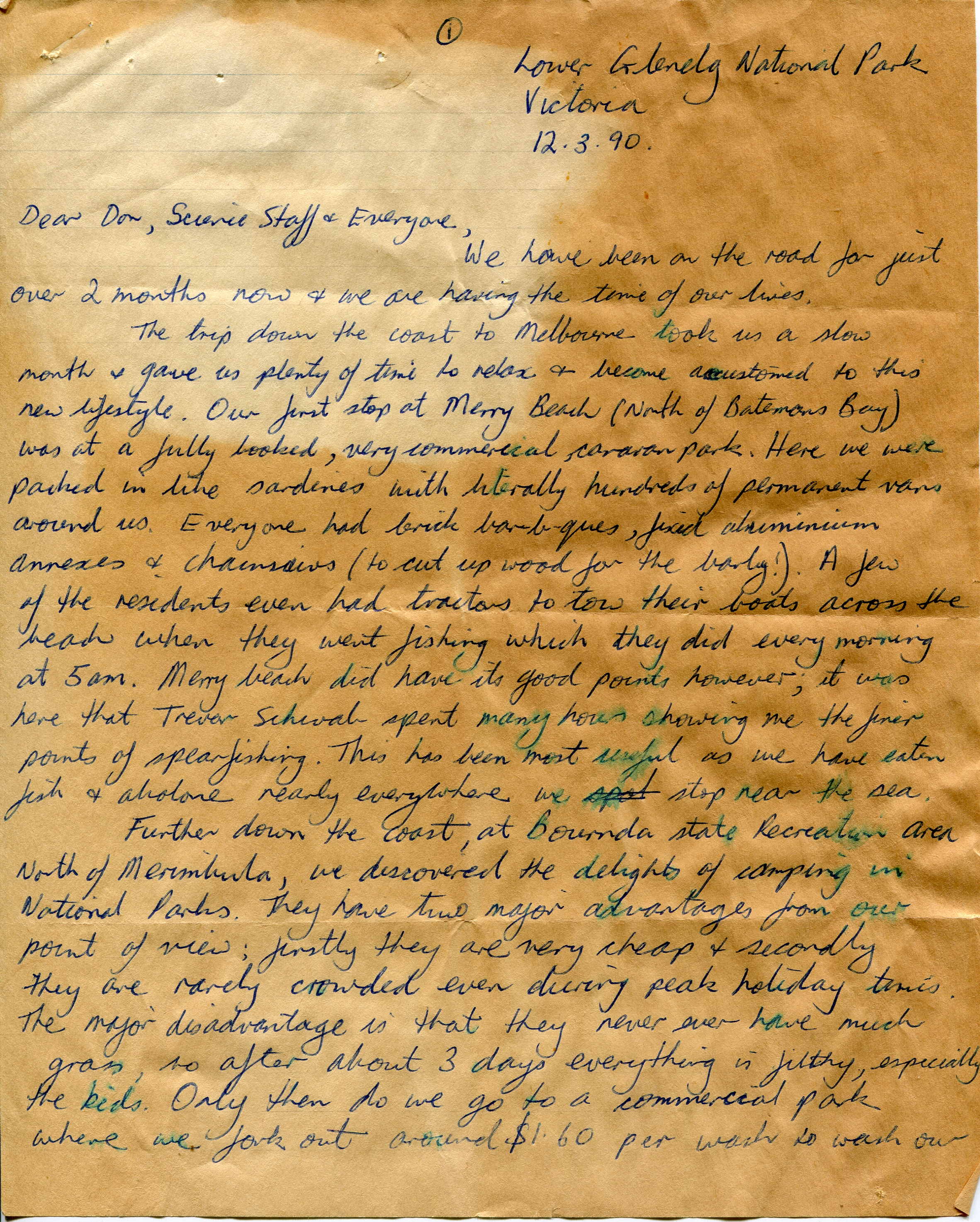
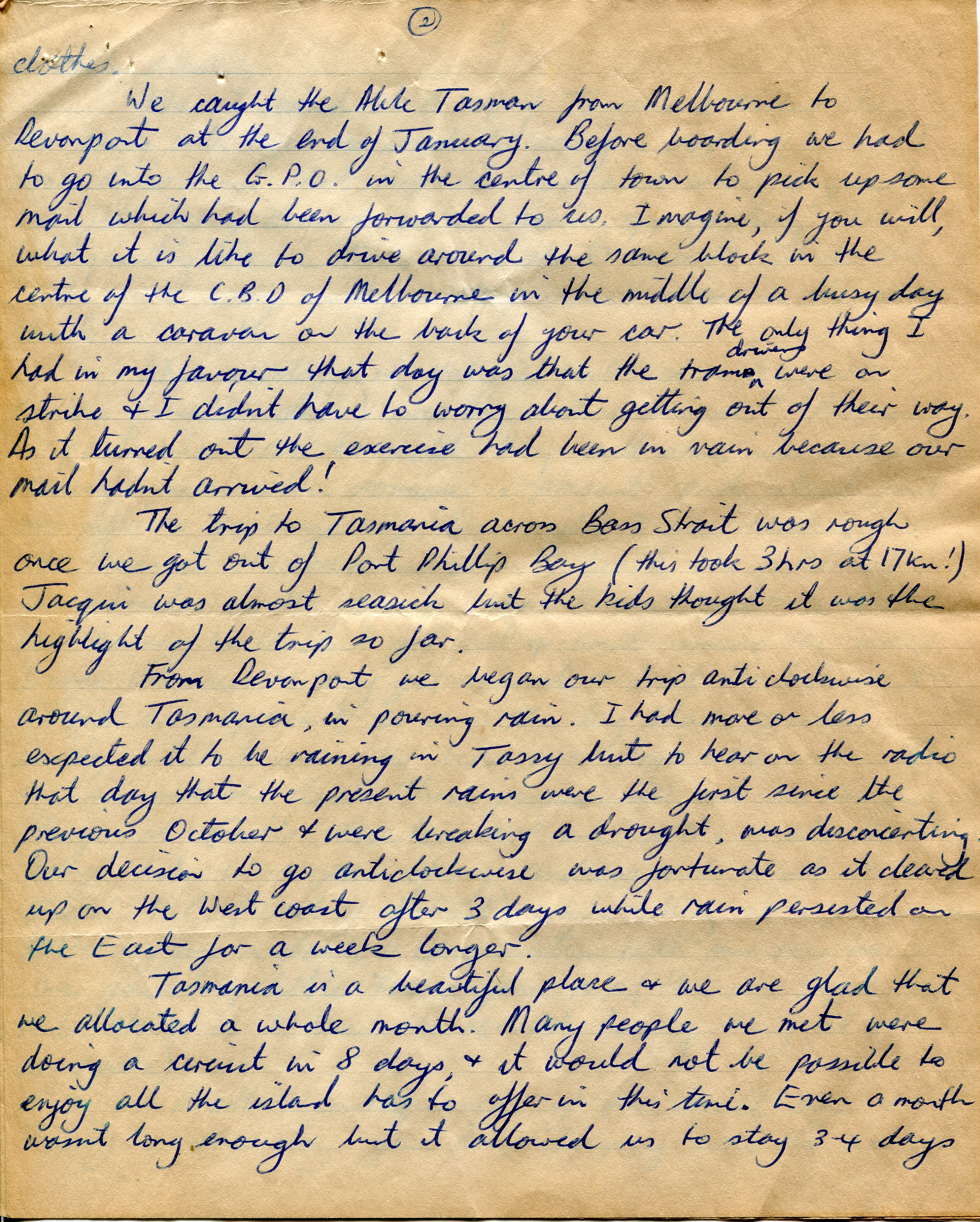
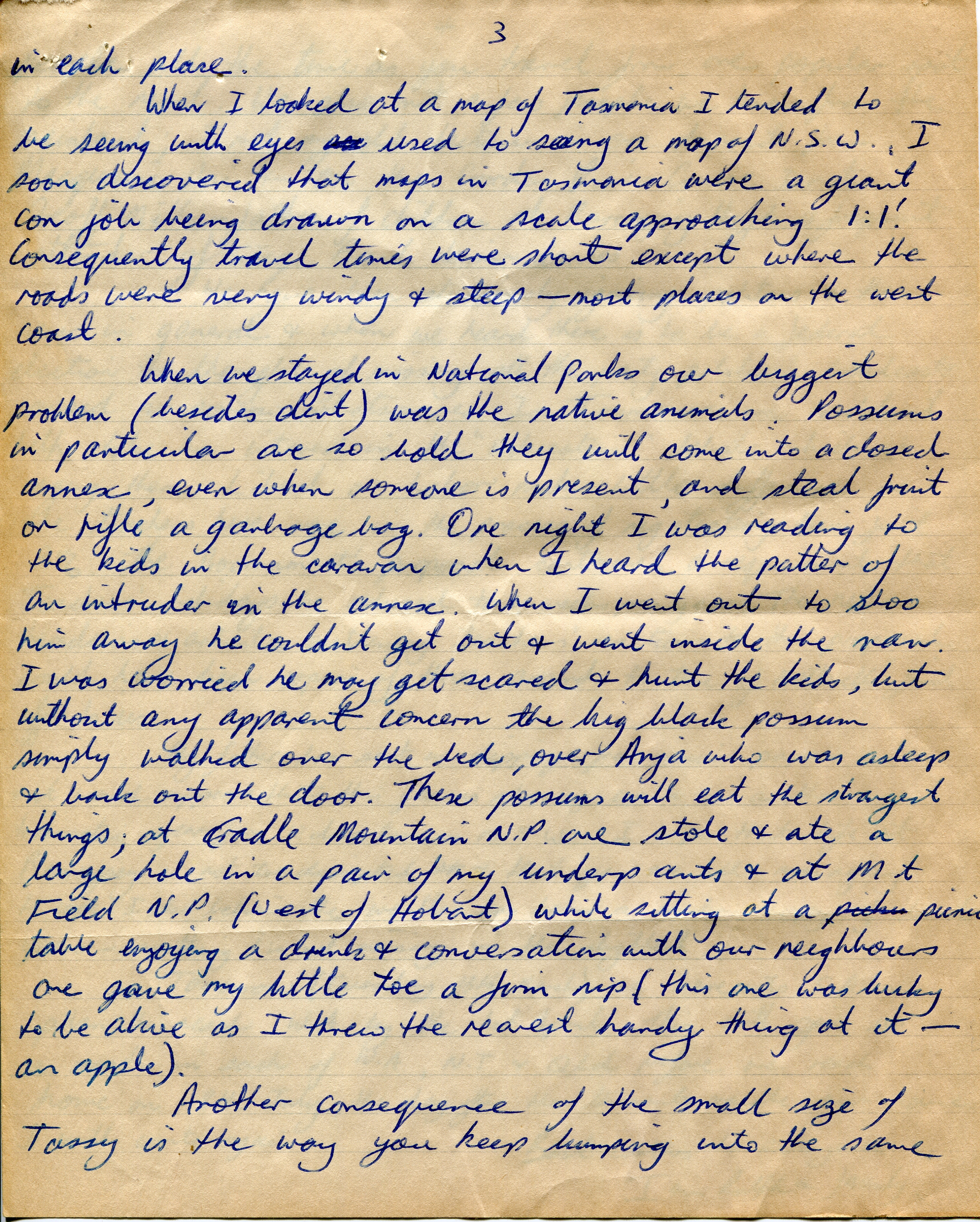
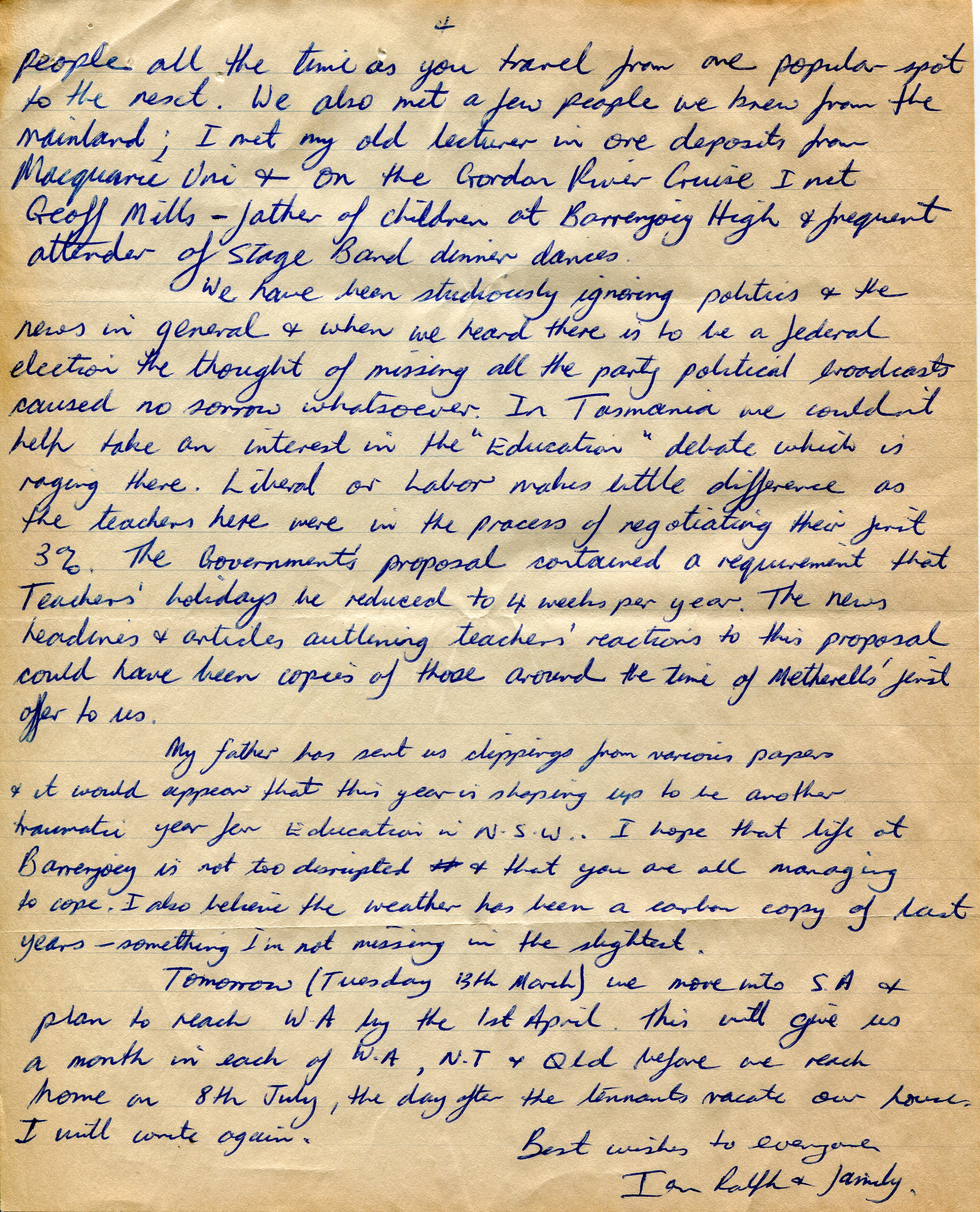
Links to other posts
In the beginning: Motivation and Planning
NSW: Merry Beach, Bournda State Recreation Area
Victoria Pt 1: Mallacoota - Lakes Entrance, Lakes Entrance - Melbourne
Tasmania: 1st - 18th February, 19th - 27th February
Victoria Pt 2: 28th February - 12th March
South Australia: 13th March - 27th March
Western Australia Pt 1: 28th March - 17th April
Western Australia Pt 2: 18th April - 5th May
Northern Territory: 6th May - 17th May
Queensland Pt1: 18th May - 31st May
Queensland Pt 2 to Sydney: 1st June - 20th June